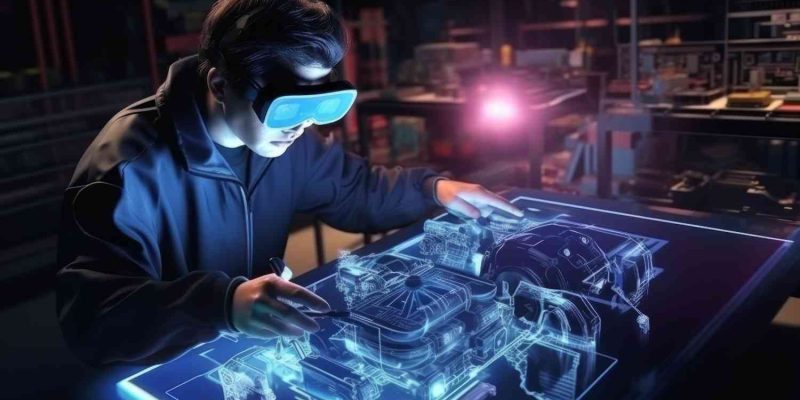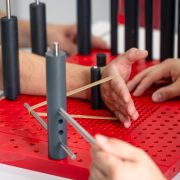In today’s fast-growing world, speed, accuracy, and innovation are the main factors for having a successful project in various industries. Since it can be applied in construction and manufacturing, healthcare, and cultural preservation, 3D Laser Scanning has become the new game-changer.
The 3D laser scanning technology provides accurate digital models of objects and environments in the real world because it can capture millions of data points in a few seconds. This invention not only simplifies processes, but it also defines the future of the operation, planning, and development of industries.
In this blog, we are going to discuss how this disruptive technology is changing the industries, its main uses, and why the potential can no longer be overlooked by businesses.
What is 3D Laser Scanning Technology?
The 3D laser scanning technology is applied to scan and capture the precise shape, dimensions, and surface of an object or an environment using high-speed laser beams. The outcome is a heavy point cloud, which can be translated to high-precision 3D representations or digital twins.
In comparison with the conventional methods of measurement, 3D Laser Scanning is:
- Faster and more efficient.
- Able to notice the slightest details.
- More precisely, fewer errors by human beings.
It virtually connects both the physical and digital worlds to offer industries insightful information to make smarter decisions.
Why Does 3D Laser Scanning Matters Today?
The industries are faced with immense pressure to achieve results at a faster rate, lower costs, and uphold quality that is uncompromising. Conventional ways are usually inadequate to satisfy these needs. This is where the 3D laser scanning technology is useful:
- Precision at Scale: Removes human error and provides precision of data.
- Time Savings: The time is related to the fact that it gives a possibility to capture millions of data points in minutes.
- Cost-Efficiency: Reduces the rework, material waste, and resource utilization.
- Data-Rich Outputs: This is an offering that gives detailed analysis, design, and simulation models.
Industries Being Revolutionized by 3D Laser Scanning
1. Construction and Architecture
The 3D Laser Scanning has become a necessity in the Architecture, Engineering and construction (AEC) industry.
- As-Built Documentation: Prepares a real-time digital document of building interiors, exteriors, and MEPs- important in the renovation, retrofitting, and maintenance.
- Integration with BIM: Point cloud information is directly processed into a BIM software to guarantee that models are valid to the real conditions and no guesses are made.
- Clash Detection: This detects clashes between the design plans and the established infrastructure and eliminates errors that would cost a lot of money before construction begins.
- Progress Tracking & Quality Control: Continuous scans allow teams to check that they are on course and are up to the specification.
- Better Security: Minimizes the use of a surveyor to go to risky or inaccessible places.
Considering the example of the modernization of old infrastructure, the use of 3D laser scanning technology allows architects to obtain the as-built information prior to the introduction of alterations and saves time and money.
2. Manufacturing and Industrial Factories
Three-dimensional laser scanning technology is simplifying production and maintenance in manufacturing and industrial factories.
- Reverse Engineering: Reproduction of the digital models of existing parts to use as the replacements or enhancements to products.
- Quality Control: Even the tiniest of deviations regarding original CAD constructions are defined through automated inspections.
- Rapid Prototyping: The scanned data will improve the speed of design and make 3D printing prototypes much faster.
- Facility Planning & Maintenance: Prepares proper plans of the plant infrastructure that is complex, and helps undergo retrofits, safety checks, and upgrades.
3. Oil, Gas, and Energy
The oil and gas sector are of great importance in terms of safety and accuracy. 3D Laser Scanning can enable engineers to survey the pipelines, refineries, and offshore platforms with less human hazard.
Some key benefits include:
- Elaborate map of the complex sites in 3-D
- Less risky inspections in areas of danger
- Enabling the digital twin to be developed to track and serve as a predictive maintenance tool.
This helps to limit the number of physical inspections and improve safety measures in the energy projects.
4. Heritage and Culture Preservation
The issues concerning the cultural landmark and historical monuments demand a very delicate touch of precision, and the 3D laser scanning technology is especially vital in this case since it accurately records all the details of the delicate objects or locations without touching them.
Examples include:
- Heritage building 3D records
- Online tours of the museums and cultural centers
- The digital-led restoration projects
This makes the cultural treasures be preserved to be used by future generations, despite the deterioration of the physical structures.
5. Healthcare and Medical Applications
Application in healthcare: Customised patient-centred solutions in healthcare are supported with 3D Laser Scanning.
- Custom Prosthetics and Implants: Provides extremely customized designs to suit the anatomy of the person.
- Surgical Planning: Adopts proper scans in pre-operative visualization and enhanced accuracy.
- Medical Research and Training: Designs 3D anatomical models to be used as educational and practice models.
Through the 3D laser scanning technology, healthcare providers are enhancing performance, minimizing errors, and also providing more personalized therapies.
6. Automotive and Aerospace
Industries 3D Laser Scanning assists in automotive and aerospace, and is based on precision and quality control:
- Re-engineering of components
- Digital model aerodynamic testing.
- Checking of prototypes against defects
The technology is quick in speeding up the product development cycles and is also the most safe.
The Future of 3D Laser Scanning Technology
The 3D Laser Scanning does not end here. The role of digital transformation in the industry will increase as industries continue to adopt it. The future developments will involve:
- AI-Powered Analysis: Automated information on scanned data.
- Cloud Integration: Integrity in exchanging 3D models worldwide.
- AR/ VR Applications: Added visualisation of training and simulation.
- Smaller size Scanners: Small handheld devices to expand their usage.
The future of workflows will be a fusion of the 3D laser scanning technology, artificial intelligence, drones, and augmented reality to make workflows smarter, faster, and more connected.
Challenges and Considerations
Although the advantages of 3D Laser Scanning are gigantic, one should remember:
- Start-up Cost: The cost of equipment and software may be excessive.
- Training Needs: The operators will need to be skilled to achieve accurate results.
- Data Management: The work with big data requires storage and processing power.
Nevertheless such problems are being mitigated gradually as technology is becoming cheaper and easier to use.
Conclusion
The globe is moving into a period where accuracy and effectiveness are what determine victories. 3D Laser Scanning is not merely a highly sophisticated instrument anymore it is a prerequisite.
In the construction site to the hospital room, in the cultural monument and in the aerospace laboratory, the 3D laser scanning technology is transforming industries by providing the linking of the physical and digital worlds.
The businesses that will not be left behind in terms of innovations will remain in the spotlight as businesses will keep on doing so, and everyone will choose whether to use the technology or will be left behind. The future is digital and 3D Laser Scanning is centre stage.
Also Read: Unlocking Efficiency: Top Plant Scanning Services in India for Smart Projects


















Comments